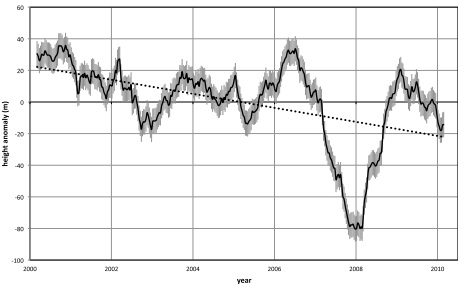Davies and Molloy are quick to point out that part of the decline from 2000 to 2010 in cloud height is due to the timing and variability of El Niño/La Niña events over the same period, however, there still seems to be evidence that at least part of the decline may remain even when El Niño/La Niña variability is accounted for.
Figure 1 (below) shows the history of the effective cloud height, as determined by Davies and Molloy from satellite observations, from March 2000 through February 2010.

The dotted line is the linear trend through the data as determined by Davies and Molloy and has a value of -44 meters per decade (+/- 22m). However, clearly the trend is influenced by the large negative departure centered around the beginning of 2008 that was related to a moderate La Niña event in the Pacific Ocean. To avoid the influence of the this event, Davies and Molloy calculate the difference between the cloud heights during the first and last years of their record and still find a decline of 31 m/dec (+/- 11m). Although this latter technique doesn't fully account for the El Niño/La Niña signal in the record, it does at least give some indication of the influence of the large negative departures in the latter half of the record, and indicates that the overall decline is not simply an artifact of a single event.
The average global cloud height is linked to the average global temperature - generally, the higher the average cloud height, the higher the average surface temperature, and vice versa. The tie-in is related to the height in the atmosphere from which clouds radiate long-wave radiation to space. The higher up they are, the cooler they are, and thus the less radiation they lose to space, which means the surface stays warmer.
Davies and Molloy calculate that on a decadal basis, the radiative forcing from increasing greenhouse gases is the same as that caused by either a decrease in the total global cloud amount of ~0.3% (which would allow more short wave radiation from the sun to hit the earth's surface) or an increase in the global average cloud height of ~19 meters (about 62 feet). All to say, that clouds play a major role in the earth's climate and that small changes in cloud characteristics can add to (via positive feedbacks) or offset (via negative feedbacks) the warming pressure put on the climate from increasing greenhouse gases. A point well-recognized by Davies and Molloy when they write "Changes in cloud properties in response to rising surface temperatures represent some of the strongest, yet least understood, feedback processes in the climate system. "
Davies and Molloy hoped to better our understanding of cloud behavior by quantifying changes in cloud heights as determined from data obtained from the Multiangle Imaging SpectroRadiometer (MISR) carried aboard the Terra satellite. The MISR data provides stereo imaging that can be used to determine the heights of clouds. The MISR data is not perfect, as it misses very thin clouds (like high level cirrus) and very homogeneous clouds (like some cirrus from thunderstorm anvils), but perhaps its biggest shortcoming is that the period of available data is still pretty short (i.e., only begins February 2000). Nevertheless, an investigation of what data is available from the MISR instrument can provide some insight as to the variability of cloud heights and their relationship to the earth's climate.
Which was the main purpose of the work of Davies and Molloy.
In full recognition of the limitations of the data, here is how Davies and Molloy conclude their paper, in their own words:
Finally, we note that the climate data record of [effective cloud height] anomalies may ultimately indicate a measure of long-term cloud feedback that may be quite separate from the correlations discussed above [i.e., correlations with El Niña/La Niña]. Ten years is unfortunately too short a span for any definitive conclusion, as the linear trend in global cloud height of -44 +/- 22 m over the last decade is partly influenced by the La Niña event, and may prove ephemeral. The difference between the first and last year of the decade, not directly affected by the La Niña event, is -31 +/- 11 m. If sustained, such a decrease would indicate a significant measure of negative cloud feedback to global warming, as lower cloud heights reduce the effective altitude of emission of radiation to space with a corresponding cooling effect on equilibrium surface temperature. Given the precision of the MISR measurements, we look forward to the extension of this climate data record with great interest.According to the calculations of Davies and Molloy, the negative climate forcing from a decrease in the average global cloud amount during the past 10 years has more than offset the positive forcing from an increase in greenhouse gases from human activities. It is little wonder that the rate of global temperature rise during this period has been so paltry!
Davies and Molloy write that they "look forward to the extension of this climate data record with great interest." We want to be the first to second that sentiment.
Reference:
Davies, R., and M. Molloy, 2012. Global cloud height fluctuations measured by MISR on Terra from 2000 to 2010. Geophysical Research Letters, 39, L03701, doi:10.1029/2011GL050506.



This Magnetic Pole Shift which is happening right now is what is causing all these Anomalies that are Plaguing Mother Earth...Great Job of letting all Like Minded People Know whats happening on a Day to Day Basis...SOTT Rules the Day...I Armagon want Everyone to know there is a New Nova Episode on YouTube called Magnetic Storm...A must see for All...